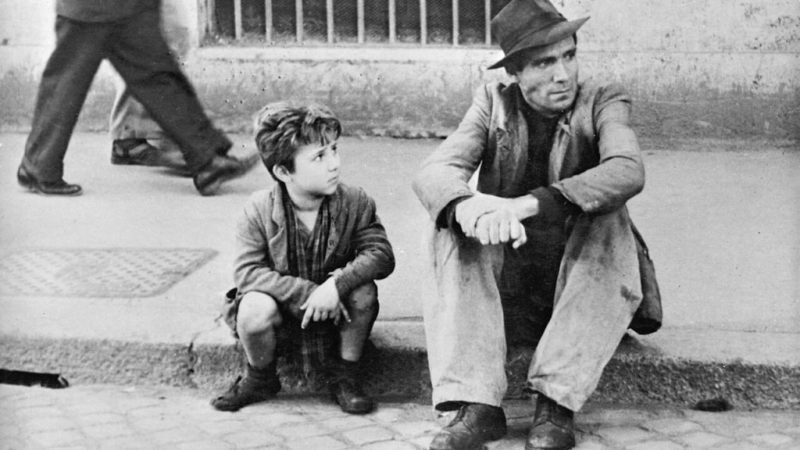
Over the past few years, in my quest to watch classic Italian films, I have seen the many faces of Italy, and Rome, specifically. These films have transformed the way that I view Italy. Perhaps they have given me a fuller picture—especially of the post-war period.
I remember asking my great grandparents and my aunts and uncles, “What was it like over there in Italy, when you were young?” In my young mind, Italy was this beautiful and romantic place with sprawling Roman ruins, little cafes, magnificent art, rolling countryside. My Aunt Phil would answer (to my horror) that it was a difficult life, they were poor. She never cared to return. She knew nothing of the things that filled my mind regarding Italy. After seeing these films, I know now what she meant. I am able to envision a portion of “her Italy.”
Poverty. Oppression. Injustice. Desperation. These are the words that flood the mind after watching Bicycle Thieves. Deemed “one of the most influential films of cinema history” by Turner Classic Movies, many consider it among the greatest films of all time. Shot on location in the Val Melaina neighborhood in Rome, during the post war years, it is about as close to reality as was possible. There were no sets. The actors had no training. Lamberto Maggiorani, who played the starring role of Antonio Ricci, was actually a factory worker, not an actor. The actor who played his son, Bruno, (Enzo Staiola) was merely a young boy who had been selling flowers on the street with his father and watching the film’s production. Yet they were both perfect. The main plot is quite simple. The film follows the story of a man who is on the hunt for his stolen bicycle. This bicycle means the world to him. It is the difference between poverty and a better way of life. It is a means to an end. Basically, in order to have a long sought after job, he must have a bicycle. After his bicycle is stolen, it seems all hope is gone.
However, it becomes quite clear to the viewer, that this is more than a story about a man searching for a lost bicycle. Antonio represents the hardships of the working class following the war. Neorealismo, or Neorealism, was a film movement that sought to display the plight of the working class. The stories were set amongst the poor and filmed on location. The backdrop is unforgiving. Much of the scenery is dilapidated buildings or new style housing projects for the poor. One of the first scenes involves the plight of Antonio’s wife, Maria, as she brings water back to their apartment. They don’t even have running water. This is not the beautiful and romantic Italy of my childhood imagination.
Yet, we want to fight for Antonio. Every part of our being wants him to come out the victor. We want him to find that bicycle. We want justice to be served. The character of the son, Bruno, is like all of us—rooting for his father to be the hero. The everyman hero. He deserves to have good things happen. But why don’t they? Of course, that is a question for all of us.
In the end, we never really know for sure what happens to Antonio and his family. But, I do now know more of the real world that my own family lived in following the Mussolini Dictatorship and the war and I can understand my Aunt Phil’s comments.

I definitely have to try to watch it again. Maybe I didn’t like it because it was depressing and I wanted more fun from movies….who knows? It sounds so interesting to me now….thanx for the inspiration!
LikeLiked by 1 person
Thanks, Stacey. It is definitely depressing, though. But so true to life.
LikeLike